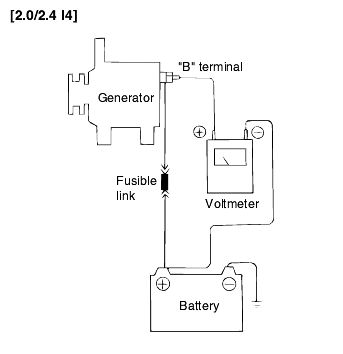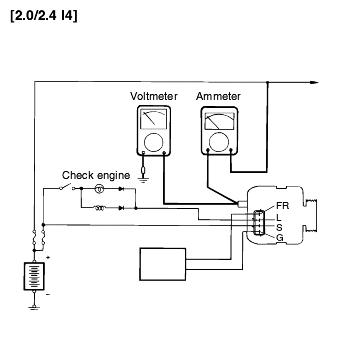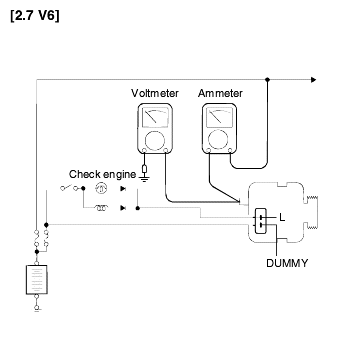
Turn the ignition switch to "OFF".
To find abnormal conditions of the connection, actions should not be taken on the two terminals and each connection duringthe test.
Connect a digital voltmeter between the generator "B" terminal and battery (+) lead wire to the battery (+) terminal. Connect the (+) lead wire of the voltmeter to the "B" terminal and the (-) lead wire to the battery(+) terminal.


Start the engine.
Switch on the headlamps, blower motor and so on. And then, read the voltmeter under this condition.
The voltmeter may indicate the standard value.
If the value of the voltmeter is higher than expected (above 0.2V max.), poor wiring is suspected. In this case check the wiring from the generator "B" terminal to the fusible link to the battery (+) terminal. Check for loose connections, color change due to an overheated harness, etc. Correct thembefore testing again.
Upon completion of the test, set the engine speed at idle. Turn off the head lamps, blower motor and the ignition switch.
Prior to the test, check the following items and correct as necessary.
Check the battery installed in the vehicle to ensure that it is in good condition. The battery checking method is de scribed in "BATTERY".
The battery that is used to test the output current should be one that has been partially discharged. With a fully charged battery, the test may not be conducted correctly due to an insufficient load.
Check the tension of the generator drive belt. The belt tension check method is described in the section "COOLING".
Turn off the ignition switch.
Disconnect the battery ground cable.
Disconnect the generator output wire from the generator "B" terminal.
Connect a DC ammeter (0 to 100A) in series between the "B" terminal and the disconnected output wire. Be sure to connect the (-) lead wire ofthe ammeter to the disconnected output wire.
Tighten each connection securely, as a heavy current will flow. Do not rely on clips.
Connect a voltmeter (0 to 20V) between the "B" terminal and ground. Connect the (+) lead wire to the generator "B" terminal and (-) lead wireto a good ground.
Attach an engine tachometer and connect the battery ground cable.
Leave the engine hood open.


Check to see that the voltmeter reads as the same value as the battery voltage. If the voltmeter reads 0V, and the open circuit in the wire between the generator "B" terminal and battery (-) terminal, a blown fusible linkor poor grounding is suspected.
Start the engine and turn on the headlights.
Set the headlights to high beam and the heater blower switch to HIGH, quickly increase the engine speed to 2,500 rpm and read the maximumoutput current value indicated by the ammeter.
After the engine starts up, the charging current quickly drops. Therefore, the above operation must be done quickly to readthe maximum current value correctly.
The ammeter reading must be higher than the limit value. If it is lower but the generator output wire is in good condition, remove the generatorfrom the vehicle and test it.
Limit value (95A generator) : 63A min. |
The nominal output current value is shown on the nameplate affixed to the generator body.
The output current value changes with the electrical load and the temperature of the generator itself. Therefore, the nominal output current may not be obtained. If such is the case, keep the headlights on the cause discharge of the battery, or use the lights of another vehicle to increasethe electrical load.
The nominal output current may not be obtained if the temperature of the generator itself or ambient temperature is too high.
In such a case, reduce the temperature before testing again.
Upon completion of the output current test, lower the engine speed to idle and turn off the ignition switch.
Disconnect the battery ground cable.
Remove the ammeter and voltmeter and the engine tachometer.
Connect the generator output wire to the generator "B" terminal.
Connect the battery ground cable.
Prior to the test, check the following items and correct if necessary.
Check that the battery installed on the vehicle is fully charged. For battery checking method, see "BATTERY."
Check the generator drive belt tension. For belt tension check, see "COOLING" section.
Turn ignition switch to "OFF."
Disconnect the battery ground cable.
Connect a digital voltmeter between the "S(L)" terminal of the generator and ground. Connect the (+) lead of the voltmeter to the "S(L)" terminal of the generator. Connect the (-) lead to good ground or the battery (-) terminal.
Disconnect the generator output wire from the generator "B" terminal.
Connect a DC ammeter (0 to 100A) in series between the "B" terminal and the disconnected output wire. Connect the (-) lead wire of the ammeterto the disconnected output wire.
Attach the engine tachometer and connect the battery ground cable.


Turn on the ignition switch and check to see that the voltmeter indicates the following value.
Voltage : Battery voltage |
Start the engine. Keep all lights and accessories off.
Run the engine at a speed of about 2,500 rpm and read the voltmeter when the generator output current drops to 10A or less.
If the voltmeter reading agrees with the value listed in the Regulating Voltage Table below, the voltage regulator is functioning correctly. If the reading is other than the standard value, the voltage regulator or the generatoris faulty.
Voltage regulator ambient temperature °C(°F) | Regulating voltage (V) |
-20 (-4) | 14.2-15.4 |
20 (68) | 13.9-14.9 |
60 (140) | 13.4-14.6 |
80 (176) | 13.1-14.5 |
Upon completion of the test, reduce the engine speed to idle, and turn off the ignition switch.
Disconnect the battery ground cable.
Remove the voltmeter and ammeter and the engine tachometer.
Connect the generator output wire to the generator "B" terminal.
Connect the battery ground cable.